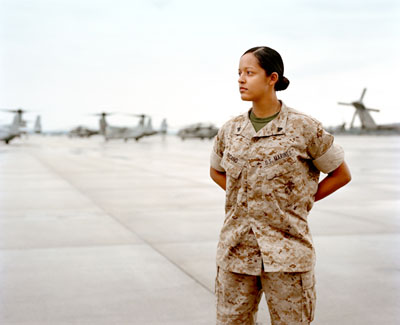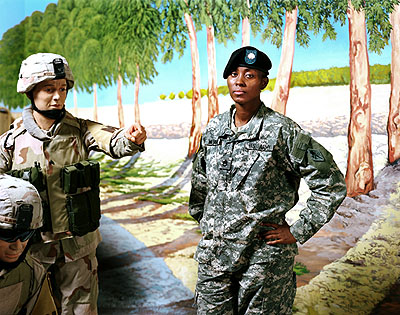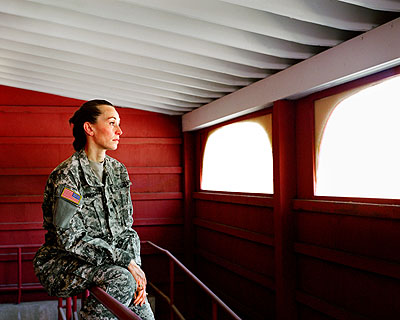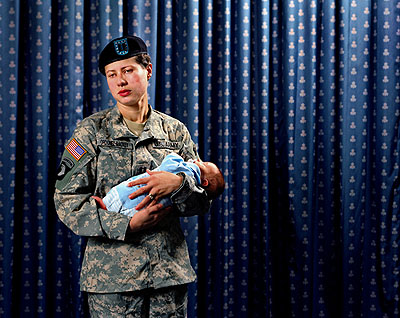
Sascha Pflaeging »
When Janey comes marching home: portraits of women combat veterans
Exhibition: 12 Sep – 14 Dec 2008
Visual Arts Center of Richmond
1812 West Main Street Richmond
VA 23220 Richmond VA
804-3530094
sascha@saschapflaeging.com
www.vmfa
Mon-Fri 11-19, Sat 10-16, Sun 13-16

WHEN JANEY COMES MARCHING HOME: PORTRAITS OF WOMEN COMBAT VETERANS September 12 – December 14, 2008 A collaboration between author-filmmaker Laura Browder and photojournalist Sascha Pflaeging, this exhibition will present a new series of approximately 45 photographic portraits and oral histories of women combat veterans. These large-scale images and accompanying text will heighten awareness, generate discussion, and broaden public understanding while also undermining stereotypes and preconceptions to reveal a more diverse, honest portrait of women soldiers and their wartime experiences in Iraq and Afghanistan. "The powerful images and accompanying stories making up this exhibition," notes exhibition curator Ashley Kistler, "should heighten awareness, generate discussion, and broaden public understanding of women soldiers and their wartime experiences in Iraq and Afghanistan. We hope When Janey Comes Marching Home will also undermine stereotypes and preconceptions about women in war." Although women are officially barred from combat positions, in the current war, where there are no front lines, notes Browder, the ban on combat is virtually meaningless. More than 180,000 women have served in Iraq and surrounding regions. Their jobs include working as convoy gunners, searching Iraqi homes, and conducting IED sweeps. When Janey Comes Marching Home: Portraits of Women Combat Veterans gives a presence and a voice to American women returning from a war zone. Pflaeging's color photographs are printed in a 30 x 40-inch format, with several images enlarged to 50 x 60 inches. A freelance photographer for such clients as Art & Auction, Getty Images, CBS, and Nylon Magazine, he travels worldwide on assignment and specializes in portraiture. "Whenever I shoot portraits," he explains, "it is important to me to try to stage as little as possible. The portrait should unveil a glimpse of the subject's spirit, how she feels, and what might be going through her head." Noting what he sees as the project's historical significance, Pflaeging adds, "My interest is in documenting these women visually while the situation is still present, their feelings and emotions still raw and very real." The resulting portraits, taken within a variety of settings at close and mid-range, capture a wealth of emotional and psychological nuance that reflect their complex, difficult and, at times, paradoxical stories. In their interviews, veterans have talked openly about issues ranging from how they deal with sexual harassment in the military to what it is like to spend 12 hours a day outside the wire in Baghdad. They share their experiences of motherhood, and tell how, as women in the military, they still had to prove themselves all the time. One Marine, Jocelyn Proano, was deployed when her daughter was a year old. She told Browder, "When I got on that plane, the Mommy mentality left me, and the Marine mentality hit me." A former Army Captain voiced her own opposition to the war—as well as her pride in serving her country and supporting her fellow soldiers in combat. And another officer told of eating lobster tails and steaks each week on her Forward Operating Base, and spending her nights lying under her cot, protected by Kevlar, text-messaging her friends back at college while her tent was bombarded by mortar fire. "Many of these women have expressed how important they think it is for the American public to understand the experiences of women fighting in Iraq," notes Browder, author of Her Best Shot: Women and Guns in America, in which she traces the way the female soldier has been seen in American popular culture from Revolutionary War times to the present day. "There are so many different stories, from the soldier whose biggest memory was running the nightclub on base to the woman who kicked in doors and manned the prison," she adds. Veterans have recounted broken marriages, and the confusion and pain that come from trying to reintegrate into civilian life. A professor of English at Virginia Commonwealth University (VCU), Browder has had a longstanding interest in documenting American culture. Her previous projects include the oral history drama Sheep Hill Memories, Carver Dreams, a collaboration with residents of Richmond's Carver neighborhood and with other VCU faculty; the documentary film, now nearing completion, Gone to Texas: The Lives of Forrest Carter, which was based on her book, Slippery Characters: Ethnic Impersonators and American Identities; and Rousing the Nation: Radical Culture in Depression America, which was named a Choice Outstanding Book of 1998. When Janey Comes Marching Home: Portraits of Women Combat Veterans remains on view through December 14, 2008. The exhibition is also expected to travel to additional venues. It is made possible by generous support from the National Endowment for the Arts , the Virginia Foundation for the Humanities , and the VCU College of Humanities and Sciences. VACR exhibitions are also supported by a generous grant from the Gwathmey Memorial Trust.

